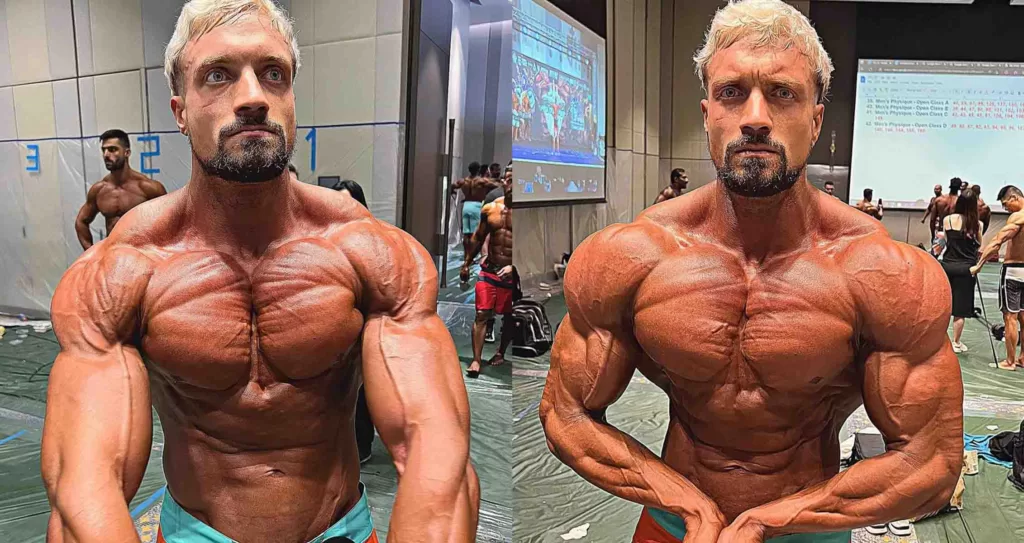Rippling muscle disease, also known as rippling muscle syndrome (RMS), is a rare neuromuscular disorder characterized by visible muscle contractions or ripples that spread across the body when a muscle is voluntarily or involuntarily stimulated. These ripples resemble waves moving under the skin, hence the name of the condition. Rippling muscle disease is a hereditary disorder that is primarily inherited in an autosomal dominant manner, although some cases have been reported to have an autosomal recessive inheritance.
The onset of rippling muscle disease usually occurs during childhood or early adulthood, with symptoms typically manifesting in the form of muscle rippling or twitching. These muscle contractions are often described as undulating or wavelike, and they can occur spontaneously or in response to various stimuli, such as movement, touch, or sound. The ripples can be observed not only in the muscles directly affected but also in neighboring muscles, creating a propagating effect throughout the body.

Symptoms of The rippling muscle disease
Living with rippling muscle disease can present unique challenges and may require adaptations in daily life. Individuals with the condition may benefit from seeking support from healthcare professionals, such as neurologists or physical therapists, who can provide guidance on symptom management and offer strategies for coping with the challenges associated with the disorder. Connecting with support groups or online communities can also provide valuable emotional support and a platform for sharing experiences with others who have rippling muscle disease.
While this disease can have a significant impact on an individual’s quality of life, it is important to note that the condition is generally not life-threatening or progressive. Most individuals with rippling muscle disease have a normal lifespan and can lead fulfilling lives with appropriate management of symptoms. Ongoing research efforts aim to further understand the underlying mechanisms of the disorder and explore potential targeted treatments that could improve symptom control and long-term outcomes for individuals affected by rippling muscle disease.
In addition to muscle rippling, individuals with rippling muscle disease may experience a variety of other symptoms related to muscle function. These can include muscle stiffness, muscle cramps, muscle weakness, and fatigue. The severity of these symptoms can vary widely among affected individuals, ranging from mild and infrequent to more pronounced and persistent. Some individuals may also develop muscle pain or discomfort, particularly after prolonged periods of muscle activity.
Causes of rippling muscle disease
The underlying cause of rippling muscle disease lies in genetic mutations affecting certain proteins involved in muscle cell membrane function. One of the main genes associated with the condition is known as CAV3, which encodes a protein called caveolin-3. Caveolin-3 plays a crucial role in maintaining the integrity of muscle cell membranes and facilitating their proper functioning. Mutations in the CAV3 gene disrupt the normal structure and function of caveolin-3, leading to the characteristic muscle rippling and associated symptoms seen in rippling muscle disease. The CAV3 gene, which produces the protein caveolin-3, is primarily to blame for the condition. These genetic mutations disrupt the normal structure and function of caveolin-3, leading to the characteristic muscle rippling and associated symptoms seen in rippling muscle disease.
This perticular disease is inherited in an autosomal dominant manner, meaning that a person only needs to inherit one copy of the mutated gene from either parent to develop the condition. However, there have been rare cases reported with autosomal recessive inheritance as well. In autosomal dominant cases, each child of an affected individual has a 50% chance of inheriting the mutated gene and developing the disease.
Prevalence of rippling muscle disease
The prevalence of rippling muscle disease is relatively low, and accurate data on its occurrence in the general population are limited. However, it is considered to be an extremely rare disorder. The exact prevalence is difficult to determine due to the small number of reported cases and the potential underdiagnosis or misdiagnosis of the condition.
This disease has been described in various ethnic groups and populations worldwide. The disorder has been reported in individuals of European, African, Asian, and Hispanic descent. It affects both males and females equally, and there is no known predilection for any specific age group. The onset of symptoms typically occurs during childhood or early adulthood, although some cases have been reported with symptom onset in later stages of life.
The mutations in the CAV3 gene that cause rippling muscle disease can vary in nature and location. Different types of mutations can lead to different clinical presentations and severity of symptoms. Some mutations may result in a milder form of the disease, while others may cause more pronounced symptoms and functional impairments.
In addition to the genetic mutations associated with rippling muscle disease, there may be other factors that influence the development and expression of the condition. Some cases have shown evidence of genetic anticipation, where the symptoms of the disorder tend to worsen and appear at an earlier age in subsequent generations. This phenomenon suggests that genetic mutations may undergo certain changes or expansions as they are passed from one generation to the next.
It is important to note that rippling muscle disease is distinct from other muscle disorders that can also exhibit muscle rippling or wave-like movements, such as myokymia or Isaacs syndrome. While these conditions may share some clinical features, they have different underlying causes and pathophysiologies.
Due to the rarity of rippling muscle disease, diagnosis can be challenging. The presence of characteristic symptoms such as muscle rippling, muscle stiffness, and weakness can raise suspicion, but further diagnostic tests are often necessary to confirm the diagnosis. Electromyography (EMG) can detect abnormal muscle activity, while genetic testing can identify the Diagnosis of rippling muscle disease
The diagnosis of rippling muscle disease is often based on the clinical presentation of muscle rippling and other associated symptoms. Additional diagnostic tests may be performed to rule out other neuromuscular disorders and confirm the presence of specific genetic mutations. Electromyography (EMG) can be used to detect abnormal muscle activity, while genetic testing can identify mutations in genes such as CAV3.
Unfortunately, there is currently no cure for rippling muscle disease, and treatment options are mainly focused on managing the symptoms and improving quality of life. Medications such as calcium channel blockers and anticonvulsants may be prescribed to help reduce muscle contractions and alleviate associated symptoms. Physical therapy and regular exercise can also play a crucial role in maintaining muscle strength, flexibility, and overall well-being. Additionally, avoiding triggers that exacerbate muscle rippling, such as sudden movements or certain medications, can be beneficial.
Rippling muscle disease’s Inheritance pattern
Rippling muscle disease is primarily inherited in an autosomal dominant pattern. This means that a person only needs to inherit one copy of the mutated gene from either parent to develop the condition. In autosomal dominant inheritance, if one parent carries the mutated gene, each child has a 50% chance of inheriting the gene and developing the disease.
However, while autosomal dominant inheritance is the most common pattern for rippling muscle disease, there have been rare cases reported where the condition is inherited in an autosomal recessive pattern. Autosomal recessive inheritance occurs when an individual needs to inherit two copies of the mutated gene, one from each parent, to develop the disease.
In autosomal recessive inheritance, both parents are typically carriers of a single copy of the mutated gene but do not show any symptoms of the disease themselves. They are considered “obligate carriers” because they pass on the mutated gene to their offspring. When two carriers have a child, there is a 25% chance that the child will inherit two copies of the mutated gene and thus develop the condition. There is a 50% chance that the child will inherit a single copy of the mutated gene and become a carrier like their parents, and a 25% chance that the child will inherit two normal copies of the gene and not develop the disease.
The occurrence of autosomal recessive cases of rippling muscle disease is relatively rare compared to autosomal dominant cases. Autosomal dominant inheritance is more common because gene mutations affect the way the caveolin-3 protein, which is made by the CAV3 gene, works.
The specific genetic mutations that cause rippling muscle disease can vary among affected individuals and families. Different mutations in the CAV3 gene can lead to variations in the severity of symptoms and the age of onset. Some mutations may result in milder forms of the disease, while others may cause more pronounced symptoms and functional impairments.
It is worth noting that the mechanisms underlying autosomal recessive inheritance in rippling muscle disease are not fully understood. In some cases, it is possible that compound heterozygosity, which occurs when an individual inherits two different mutations in the same gene, may be responsible for the autosomal recessive inheritance pattern. Alternatively, there may be other genetic factors or modifying genes that contribute to the occurrence of rippling muscle disease in an autosomal recessive manner.
It is important for individuals with a family history of rippling muscle disease to undergo genetic counseling and testing to understand the specific inheritance pattern in their case. Genetic testing can identify the presence of mutated genes and provide information on the likelihood of inheritance for future generations. This information is crucial for family planning decisions and for providing appropriate support and care for affected individuals.
The challenges of living with rippling muscle disease

Living with rippling muscle disease can present unique challenges and may require adaptations in daily life. Individuals with the condition may benefit from seeking support from healthcare professionals, such as neurologists or physical therapists, who can provide guidance on symptom management and offer strategies for coping with the challenges associated with the disorder. Connecting with support groups or online communities can also provide valuable emotional support and a platform for sharing experiences with others who have rippling muscle disease.
While rippling muscle disease can have a significant impact on an individual’s quality of life, it is essential to note that the condition is generally not life-threatening or progressive. Most individuals with rippling muscle disease have a normal lifespan and can lead fulfilling lives with appropriate management of symptoms. Ongoing research efforts aim to further understand the underlying mechanisms of the disorder and explore potential targeted treatments that could improve symptom control and long-term outcomes for individuals affected by rippling muscle disease.
Recent Shocking News on Rippling Muscle Disease
Rippling Muscle Disease (RMD) has been thrust into the public eye as a result of the untimely death of German bodybuilder Jo Lindner, who was only 30 years old when he passed away on July 1st, 2023. It was revealed that Lindner, who was fondly known as “Joesthetics” by his contemporaries, had passed away through posts on social media made by his close friends. His peers responded tragically to the news of Lindner’s passing.
Just one month before he passed away, Lindner had made his struggle with RMD known to the general public. In June, Bradley Martyn, a popular YouTuber, hosted an episode of his series titled Raw Talk, in which he discussed his struggles with his health. He described his illness as being similar to a constant muscle cramp.
The German bodybuilding sensation had an impressive internet following, with over 900,000 subscribers across all of its many social media platforms. Lindner would constantly impart knowledge to his followers regarding health and wellness topics like food and exercise, and he would even show off his enormous shoe collection. According to a story from The Metro, the influential person claimed that shortly before his passing, he had been suffering from pain in his neck.

According to The Metro, the bodybuilder had been residing in Thailand over the past few years and published films on his social media accounts depicting life in the country. The German celebrity also posted videos to his channel for his 940,000 fans, in which he discussed his nutrition, his gym routine, and various aspects of his shoe collection.
On Instagram, his girlfriend Nicha posted a confirmation of his death and said that he passed away yesterday from an aneurysm. She paid respect to “the amazing and incredible person in this world” as she described him.
She posted on various social media platforms, “Yesterday his life was taken from us by an aneurysm… I was there with him in the room.. he put on the necklace on my neck that he made for me.. then..we just lay down cuddling.. waiting for the time to go meet Noel at the gym at 16.00..he was in my arms. then this is just happening too fast.. 3 days ago he kept saying that he had pain in his neck.. we did not really realize it… until it was too late. “I was there with him in the room… she added.
Conclusion
CAV3 gene mutations are the primary cause of the rare neuromuscular disorder known as rippling muscle disease. It is inherited in an autosomal dominant manner, although autosomal recessive cases have been reported. The prevalence of the condition is low, and accurate data on its occurrence are limited. The disorder can affect individuals from various ethnic backgrounds and manifest at different ages. Genetic mutations and potential additional factors contribute to the development and expression of the condition. Timely diagnosis and appropriate management are essential for individuals affected by rippling muscle disease.
While rippling muscle disease is typically inherited in an autosomal dominant pattern, there have been rare cases reported with autosomal recessive inheritance. Autosomal dominant inheritance occurs when a person inherits a single copy of the mutated gene, while autosomal recessive inheritance requires inheriting two copies of the mutated gene. Genetic counseling and testing are essential for individuals with a family history of the disease to understand the specific inheritance pattern and make informed decisions.
Disclaimer:
The author’s views are his or her own. The facts and opinions in the article have been taken from various articles and commentaries available in the online media and Eastside Writers does not take any responsibility or obligation for them.
Note: Contact our Writers at www.eastsidewriters.com for writing Blogs/Articles on any niche. We have experts in various domains from Technology to Finance and from Spirituality to Lifestyle and Entertainment.






